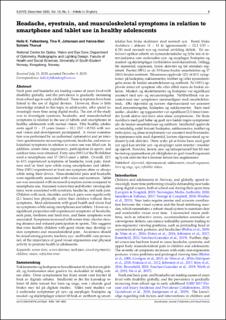Headache, eyestrain, and musculoskeletal symptoms in relation to smartphone and tablet use in healthy adolescents.
Peer reviewed, Journal article
Published version
Permanent lenke
https://hdl.handle.net/11250/2725603Utgivelsesdato
2020Metadata
Vis full innførselSamlinger
Originalversjon
Falkenberg, H. K., Johansen, T. R., & Thorud, H.-M. S. (2020). Headache, eyestrain, and musculoskeletal symptoms in relation to smartphone and tablet use in healthy adolescents . Scandinavian Journal of Optometry and Visual Science, 13(2), 8–14. https://doi.org/10.5384/sjovs.vol13i2p8-14Sammendrag
Neck pain and headache are leading causes of years lived with disability globally, and the prevalence is gradually increasing from school age to early adulthood. These symptoms have been linked to the use of digital devices. However, there is little knowledge related to this topic in adolescents, who spend increasingly more time using digital media. The aim of the study was to investigate eyestrain, headache, and musculoskeletal symptoms in relation to the use of tablets and smartphones in healthy adolescents with normal vision. Fifty healthy adolescents aged 11 – 13 years (mean = 12.1 (SD = 0.53)) with normal vision and development participated. A vision examination was performed by an authorised optometrist and an interview questionnaire measuring eyestrain, headache, and musculoskeletal symptoms in relation to screen use was filled out. In addition, screen time, ergonomics, participation in sports, and outdoor time were obtained. Forty-nine (98%) of the 50 children used a smartphone and 17 (34%) used a tablet. Overall, 12% to 41% experienced symptoms of headache, neck pain, tiredness and/or tired eyes while using smartphones and tablets. Nine (18%) experienced at least one symptom often or always while using their device. Musculoskeletal pain and headache were significantly associated with vision and eyestrain. Tablet use was associated with increased symptom scores compared to smartphone use. Increased screen time and shorter viewing distance were associated with eyestrain, headache, and neck pain. Children with neck- shoulder- and back pain were significantly (2.1 hours) less physically active than children without these symptoms. Most adolescents with good health and vision had no symptoms while using smartphones and tablets. However, a significant proportion still experienced symptoms of headache, neck pain, tiredness and tired eyes, and these symptoms were associated. Symptoms increased with screen time, shorter viewing distance and reduced participation in sports. This suggests that even healthy children with good vision may develop vision symptoms and musculoskeletal pain. Awareness should be raised among parents, teachers, eye care- and health care personnel, of the importance of good visual ergonomics and physical activity to promote health in adolescents.

